Let’s dive deep into how a car tire can hold air.
We start by looking at the different parts of the tire to better understand how it all works together.
Table of Contents
The tire category type may vary depending on the vehicle in question but each tire is made up of the same general components. The more a motorist learns about these components, the easier it is to learn about a tire’s ability to hold air.
The short answer is that the beads, inner liner and bead filler will work together to hold the air inside the tire.
It still behooves a motorist to learn more about the different parts of each tire.
The inner liner plays a key role in holding the air inside of a tire because it is a rubber compound that has been bonded to the inside of the cord body. This allows the tire to retain air under pressure.
The inner liner functions in the same manner as an inner tube and there is no cord reinforcement to speak of.
The days of car tires having inner tubes inside of them have long since come to an end. Instead, the beads, bead filler, and inner liner work together as a means of holding air inside of the tire.
In order to truly understand the manner in which these items come together to hold air inside of a car tire, it is important to start from the inside out.
The tire beads are responsible for ensuring that the tire remains attached to the rim, at the wheel’s outer edge.
These beads are made of high tensile steel wires that have been copper, brass or bronze plated.
When the wheel is rolling, the tire beads are responsible for making sure that the wheel does not slide out of place.
Within the beads of the tire, there is a rubber compound. This is what is known as bead filler. The lower sidewall and bead area are provided with the necessary stability.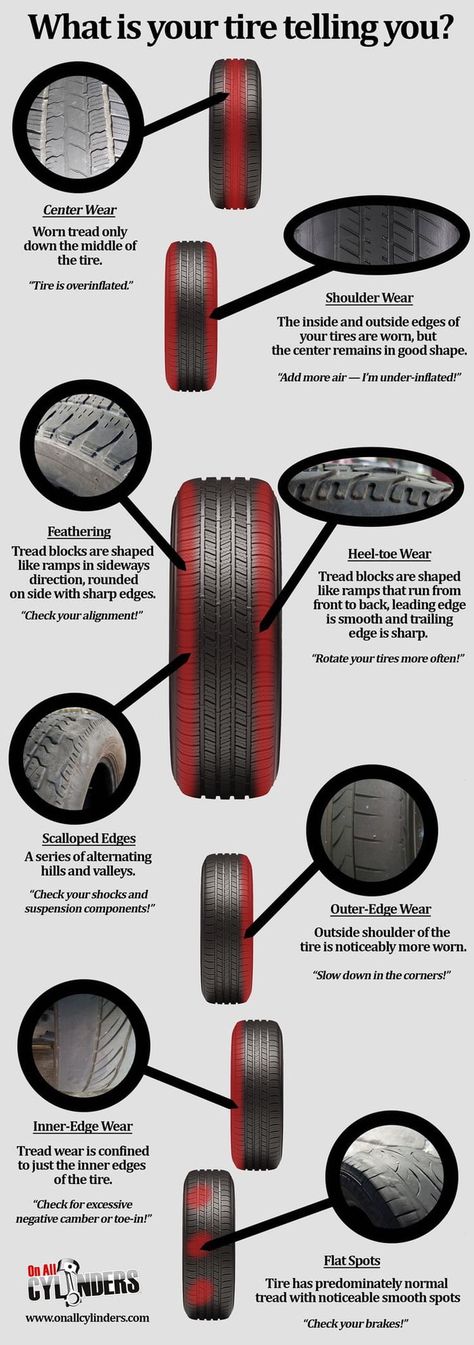
The tire performance characteristics are determined by the stiffness and density of the tire’s bead filler.
The tire’s strength is derived from the radial cord body. The radial cord body also transfers cornering forces from the tread to the wheel. Body plies make up the cord body, which are also known as rubber-coated plastic cords.
These plies are typically made of nylon, rayon or polyester. In most instances, polyester is used.
The sidewall consists of the area that extends from the bead to the tread. Also known as the side of the tire, the sidewall serves as a protective covering for the body of the cord.
If the motorist needs any additional information about their tire, it is going to be found on the sidewall.
Speed rating, tire size and load index are among the information included. The rubber compounds that are designed for sidewalls have been specially formulated to resist the damages caused by snags and cuts.
Of course, it should go without saying that the tread on the tire is one of the most crucial aspects. Since this is the portion of the tire that comes into contact with the road’s surface the most often, it is easy to see why there are so many options to choose from.
In addition to wear, traction, handling, fuel economy, and resistance, there are other characteristics of the tire that have to be taken into account.
For starters, those who reside in areas with more wintry conditions to contend with cannot underestimate the importance of all-season tires.
Tires with circumferential tread grooves are the best choice in these instances. Thanks to the grooves that these tires contain, water is able to pass through and stay off the tread. Meanwhile, there are other all-season tires that are designed with high-speed emergency usage in mind.
They will come with an asymmetrical tread pattern.
In addition to these tread patterns, there are also sizable tread block elements on the tire’s outside shoulder.
Those elements are designed to support dry performance, as the inner shoulder is made up of a larger number of smaller tread elements that improve the tire’s ability to handle snow traction and wet, wintry conditions.
The tire hold air by the pressure between the rim and the tire. There are no holes or cracks for the air to slip though. This also means that we don’t have a tube in the tires. They are simply help together by the pressure of the air inside the tires.
Let’s take a closer look at some of the most commonly asked questions about car tires and their ability to hold air:
When the tires are cold, most passenger cars will recommend using 32 psi to 35 psi of air in the tires of a passenger car.
The pressure needs to be checked when the tires are cold because the tires will create friction when they are rolling along the street. This creates a higher level of air pressure and increases the temperature in the process.
The full set of tires should always be replaced, since a refusal to do so can cause serious damage to the system of the vehicle.
In certain circumstances, it is best to only change one or two.
This is especially important if the difference in tread for each tire is particularly pronounced.
This is one of the more common queries that takes place and there is a very simple answer for this. The tires that come with a new car are not actually manufactured by one of the major companies.
The manufacturer of the car is responsible for them.
In most instances, the rubber that they use is quite soft, leading to faster wear outs.
When it comes to replacing tires, this is something that we do not always handle in a timely manner. Instead, we often wait until our hand is forced and there is no choice but to get the tires replaced.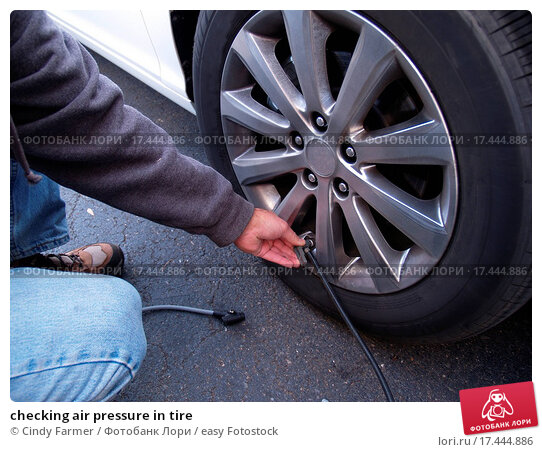
Fortunately, there are a few telltale signs that it is time for new tires that any motorist can keep an eye out for:
Once a tire begins to deflate, there are bulges at the side. It won’t be long before cracks and gouges start to show themselves. If any of these imperfections start to become more noticeable, it is time to take the vehicle to the dealer.
Let them take a look before things get too far out of hand.
The good old-fashioned penny test will certainly come in handy here. Put a penny into the tread of the tire and make sure that Lincoln’s head is facing downward. If you are able to see the top of Lincoln’s head, this means that the tread is too low.
Be sure to replace the tire immediately.
Many modern tires also come with wear bars. If the tires have been worn down to these bars, this means that the motorist is overdue for a replacement.
The level of tire pressure also goes a long way towards telling the story.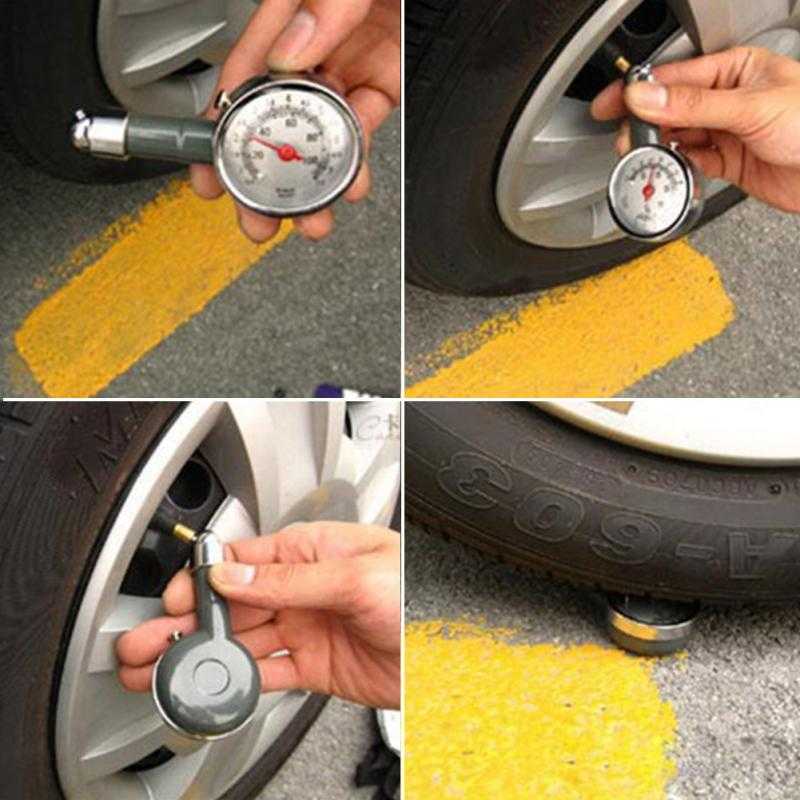
The average tire deflates at a rate of one pound per square inch each month. The tires are not going to wear down within one month’s time but it still behooves motorists to be proactive instead of reactive.
When extreme cold arrives, the pressure in the tires will drop accordingly. Meanwhile, summertime brings a whole new challenge.
This is when drivers are forced to contend with excessive heat buildup inside of the tire.
Tires must be properly inflated during each time of year. Tires that are not properly inflated are going to wear out much, much faster than their properly inflated counterparts.
Thumping and vibration while driving are especially problematic. Does the thumping feel like it is coming from the back seat? That means that the tires could be out of balance.
If the vibration is taking place in the steering wheel, this typically means that there is a suspension issue. Once the ride is not as smooth as it should be, it is time to head to the dealer.
Once the ride is not as smooth as it should be, it is time to head to the dealer.
Last but certainly not least, the motorist must maintain awareness of the best types of tires for their personal driving situation.
All season tires are the most commonly chosen in the modern day. They provide the motorist with the traction that they need, all year round.
For most models, the tread range is going to fall anywhere between 60,000 to 100,000 miles.
In order to understand the importance of all season tires, it is crucial to know why they are so effective. Thanks to their tread patterns and rubber compounds, they are able to be utilized in a wide range of conditons.
This keeps the driver from having to swap out their tires for new ones every time that they look up.
These tires are even designed with the ability to handle light snow in mind, making them a no-brainer for most drivers.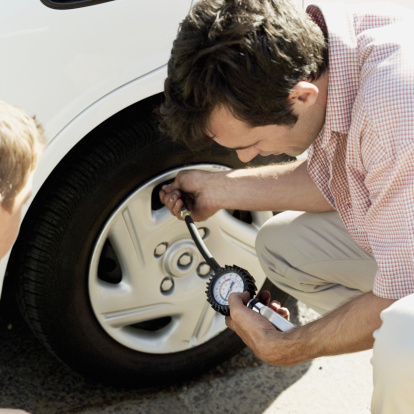
There are often debates as to whether it is better to utilize all-weather tires or all-season tires. As with most choices of this nature, it will all depend on the weather conditions at hand.
Those who reside in warm, dry or mild conditions are likely able to use all-season tires.
Meanwhile, anyone who resides in a more wintry climate will want to choose all-weather tires. When slush, snowfall and heavy rains take place, all-weather tires are able to handle these conditions far more easily. Don’t make the mistake of relying on all-season tires in these instances.
Before we take off, it is time to shatter one very common misconception that has been allowed to circulate for far too long. No, dealerships are not responsible for the over-inflation of tires.
The tires are inflated to the proper specifications.
So why does this misconception still linger? The tires will often expand once the motorist hits the roadway.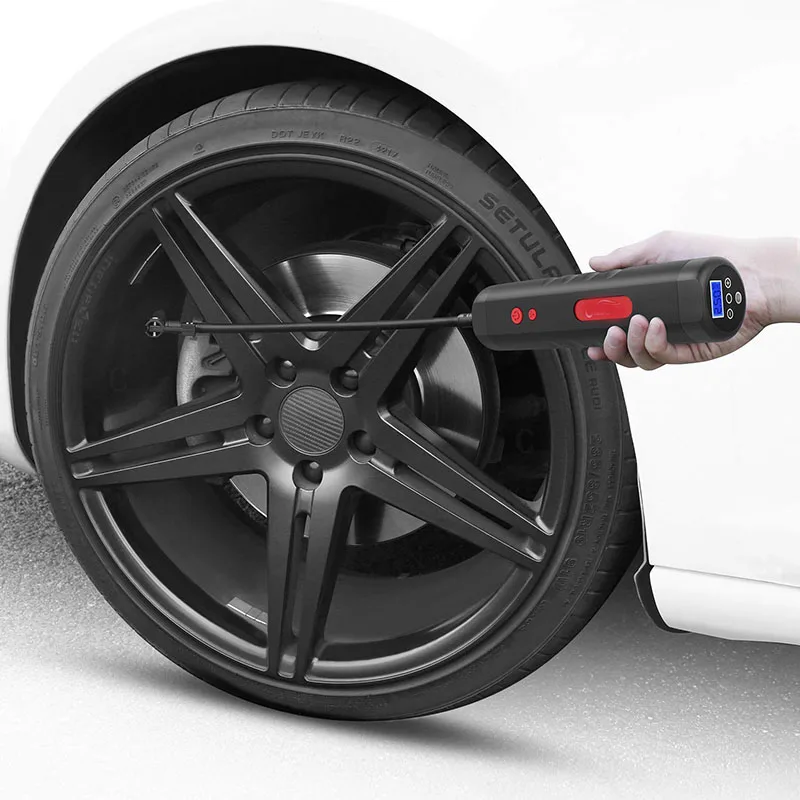 Since the shop is cool and the roads are warm, this is a natural occurrence.
Since the shop is cool and the roads are warm, this is a natural occurrence.
This is not the dealership’s fault and is 100 percent normal.
What Are The Different Parts of a Tire?
What Do The Numbers on my Tire Mean?
What Are All Season Tires and Are They Right For You?
How Does Air Stay In a Car Tire?
5 Signs You Need New Tires
We all know that routine maintenance is important for everything from our computers to our cars. But sometimes, we fall short. One of the most neglected routine car maintenance tasks is to check tire pressures and inflate them as necessary. That’s why newer cars have tire pressure warning lights, or tire pressure monitoring systems (TPMS), that let you know when you have under- or over-inflated tires (when any tire is 25% underinflated).
Older vehicles don’t have this useful warning light. So, don’t wait for a rupture to check or change a tire. Use this guide to learn how to check the pressure (PSI) of your vehicle tires and how to inflate them to the proper air level.
The number one reason why you should periodically check your tire pressure is SAFETY, but there are monetary and handling reasons as well:
Proper tire pressure (as recommended by the manufacturer) is needed to drive safely and efficiently. According to a 2009 report by the National Highway Traffic Safety Administration:
“…about 28% of light vehicles on our Nation’s roadways run with at least one underinflated tire. Only a few psi difference from vehicle manufacturer’s recommended tire inflation pressure can affect a vehicle’s handling and stopping distance. Poor tire maintenance can increase incidences of blowouts and tread separations. Similarly, underinflation negatively affects fuel economy.”
When your tires are underinflated, the tires get fatter, increasing their surface area.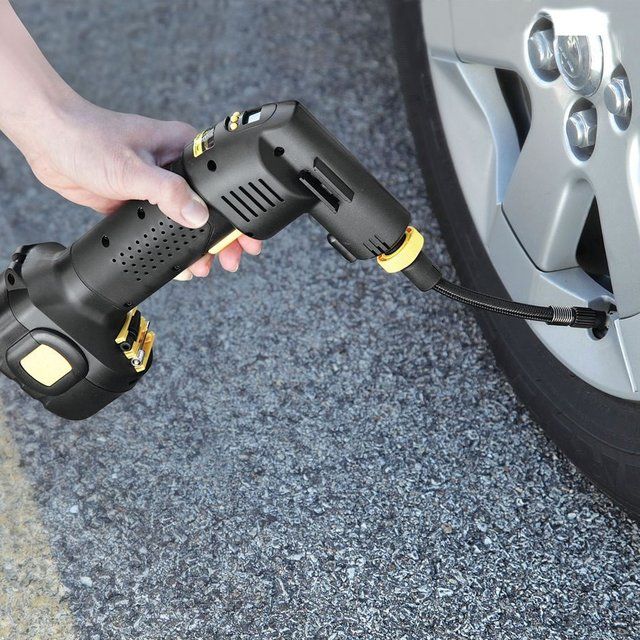 This causes high heat generation and extra resistance that could result in higher fuel costs, blown out tires, tire wear, and loss of control.
This causes high heat generation and extra resistance that could result in higher fuel costs, blown out tires, tire wear, and loss of control.
If you feel like you’re spending too much at the gas pump, it might be your tires. According to the US Department of Energy:
“You can improve your gas mileage by 0.6% on average—up to 3% in some cases—by keeping your tires inflated to the proper pressure. Under-inflated tires can lower gas mileage by about 0.2% for every 1 psi drop in the average pressure of all tires.”
In addition to safety and fiscal concerns, keeping your tires properly inflated will also reduce your impact on the environment. When your tires are properly inflated, you’ll pay less for gas, replace your tires less often, and improve your handling and stopping distance. You’ll also feel better knowing that you are emitting less carbon dioxide and other harmful substances into the atmosphere.
What is the right PSI level?PSI stands for pounds per square inch.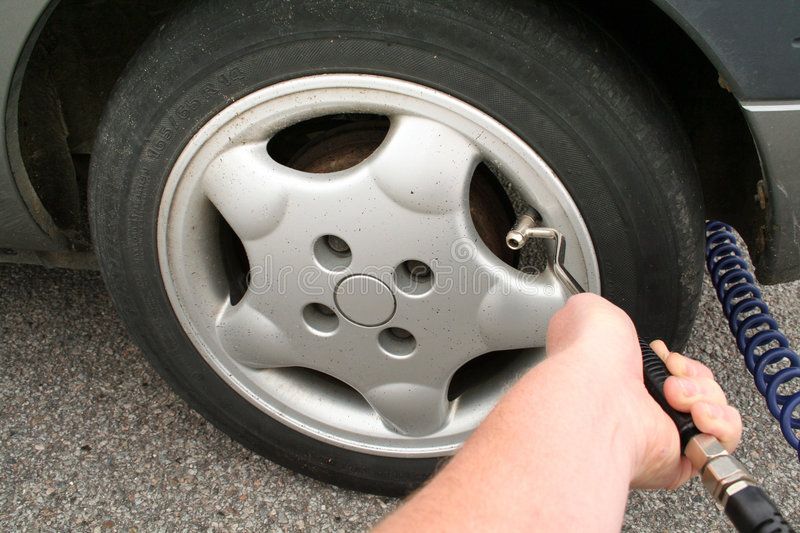 The recommended PSI for your vehicle’s tires is determined by the vehicle’s manufacturer and the recommended tire size.
The recommended PSI for your vehicle’s tires is determined by the vehicle’s manufacturer and the recommended tire size.
One big question that we get is whether you should follow the recommended PSI level on the tire itself or the recommended PSI level printed in your owner’s manual or on the placard inside of door edge, glove box door, or fuel door.
Do NOT use the max PSI that is printed on the tire sidewall. This is not the recommended PSI level. The pressure amount on the tire is normally the maximum allowed pressure. The correct PSI level is almost always less than what you see printed on the side of the tire. Over-inflation can lead to poor handling and comfort, overheating and blow outs. Over 40 PSI is a dangerous level for most vehicles!
Make sure you always use the recommended PSI as provided in your owner’s manual and don’t go any more than 5 PSI over the recommended level. You should make sure, however, that your tires are appropriate for your vehicle.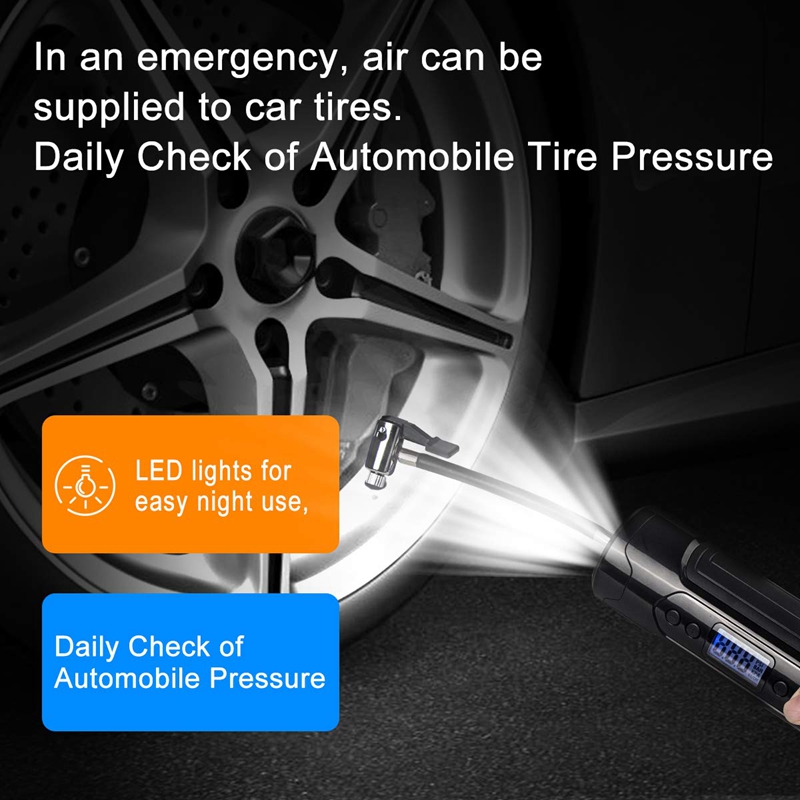 You can do this by checking the car’s owner’s manual or the placard that is on the inside of the driver-side door, glove box, or fuel door.
You can do this by checking the car’s owner’s manual or the placard that is on the inside of the driver-side door, glove box, or fuel door.
Most car tire pressure recommendations range from 30-35 PSI.
How often should I check tire pressure?A question in many minds is when is the appropriate time and frequency for checking and inflating vehicle tires.
A quick google search will reveal a variety of different opinions and suggestions. Some say that you should check your tire pressure every 2nd visit to the gasoline station, while others say once every 3-6 months is OK.
Most tire and vehicle manufacturers, on the other hand, will say that you should check your tire pressure at least once every month, or every second trip to the gas pump. Your tires will lose around 1 PSI each for every month that goes by.
Unfortunately, not one answer will fit every situation. There are several factors that influence how often you should check your tire pressure, including:
Did you know that for every 10°-drop in temperature, you lose 1 pound of pressure?
If you have a leaky valve or a small puncture, you will lose air pressure much more quickly.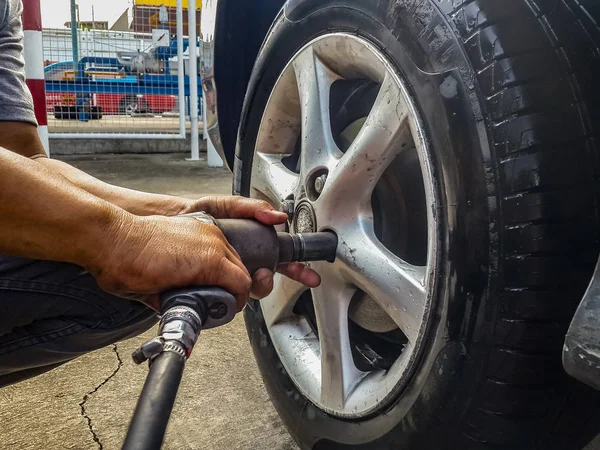 This is one more reason why you should frequently check the tire pressure on all of your tires.
This is one more reason why you should frequently check the tire pressure on all of your tires.
Since tire pressure constantly fluctuates, it’s important to check it periodically (at least once a month) and add air as necessary.
How to Check Tire PressureFinding out the tire pressure of your tires is incredibly easy. All you need is a pressure gauge (click here for additional items you should have in your vehicle).
Just make sure that you are checking your tires when they are relatively cold. If you check your tire pressure after a long drive, you will get an inaccurate reading since heat will temporarily increase the tire pressure reading.
Unfortunately, not all pressures gauges are created equal. Some are better than others. We recommend shelling out a couple extra bucks for a digital reader. The pop-up, stick-type versions are notoriously inconsistent and unreliable. A reliable gauge will be well worth the investment.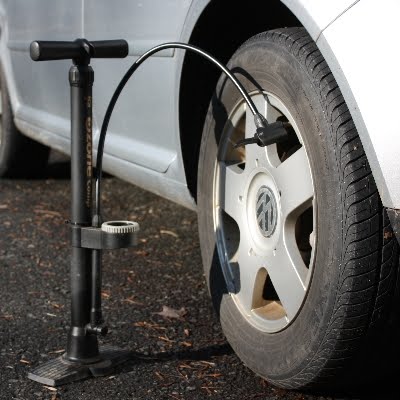 Prices range from about $5 for the stick-type and about $30 for the digital and dial-type pressure gauges.
Prices range from about $5 for the stick-type and about $30 for the digital and dial-type pressure gauges.
You can also check your tire pressure at most gas stations or auto repair shops. Discount Tire offers free tire pressure checks and inflation.
Here are the steps for checking your tire pressure:
It should only take you a couple minutes to check the air pressure of your vehicle’s tires. As soon as you restore tire pressure to the recommended levels, you’ll start experiencing the safety and savings that come with this regular maintenance task.
Watch this video for more information on how to check your tire pressure:
How to Inflate TiresHere are the steps for adding air to your tires:

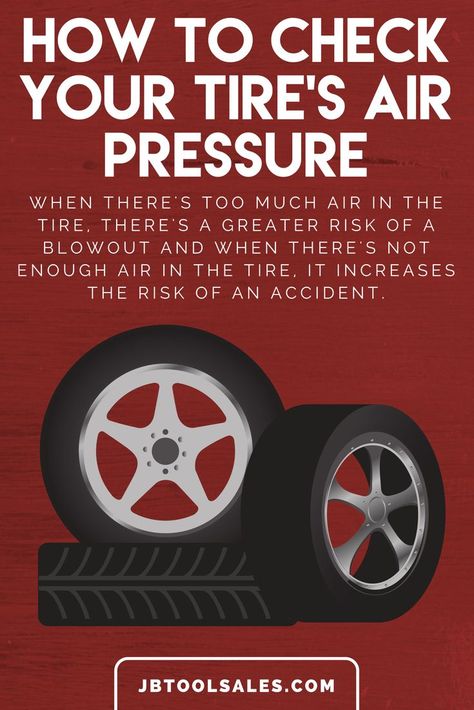 It will be pretty noisy.
It will be pretty noisy.
Remember, just one drop in PSI can lower your gas mileage by about 0.2%. For every 3-4 PSI units that your tire is underinflated, you are burning around 1% more fuel.
If your tires are flat, then you probably have a leak. Add air and see if you can drive around without the pressure dropping. If you hear air escaping the tire while you are filling up, then it’s time to replace the tire.
Tip: Learn how to use the air pump properly first. Some automatic air pumps at gas stations have a handle/switch that you need to depress in order for the air to flow. When you let go of the handle, a tire pressure gauge will pop out showing you the tire pressure. At the same time, air will be slowly released. If your air pump has this kind of handle, then you will want to hold down the handle for most of the time, periodically releasing it to check the pressure reading. Consult your own tire pressure gauge for accuracy.
If your air pump has this kind of handle, then you will want to hold down the handle for most of the time, periodically releasing it to check the pressure reading. Consult your own tire pressure gauge for accuracy.
If you check your tire pressure at least once a month as recommended, you’ll also get a good idea of the general condition of your tires and when you should replace them.
We recommend using the penny test:
Source: bridgestonetire.com
Click here for more car maintenance tips. Click here for car winterization tips.
Click here for car winterization tips.
Auto Simple wants you to find a vehicle you love at a price you can afford. We carry a large selection of hand-picked, Certified Pre-Owned vehicles, all with a 6 month/6,000-mile Powertrain Warranty.
If you have any questions, don’t hesitate to speak with one of our Online Specialists or give us a call:
Chattanooga, TN – (423) 551-3600
Cleveland, TN – (423) 476-4600
Dayton, TN – (423) 775-4600
Dalton, GA – (706) 217-CARS (2277)
Follow us on social media for more useful information on buying, selling, and maintaining vehicles: Facebook, Twitter, Youtube, and Google+.
A tube tire for a passenger car consists of a tire and a tube with a valve fitted with a cap or key cap.
The chamber is an annular closed rubber tube with a rubber-metal valve.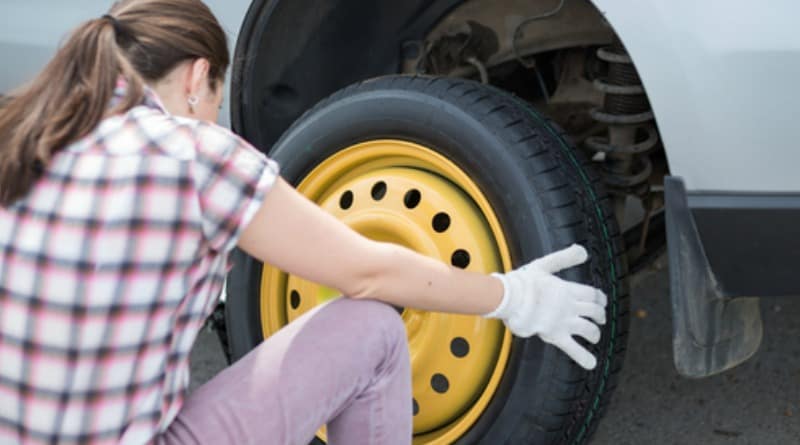 It is made of elastic rubber and serves only to hold compressed air.
It is made of elastic rubber and serves only to hold compressed air.
Chambers operate under severe conditions, experiencing alternating deformations at high temperatures. Therefore, rubber for cameras should be airtight, elastic, resistant to thermal aging, not change their physical and mechanical properties at different ambient temperatures. The size of the chamber must strictly correspond to the size of the tire with which it is completed.
If we are talking about tires for passenger cars, tube tires are now a thing of the past. Foreign manufacturers have abandoned tubes, and now only tubeless tires are on the market. Cameras can be seen on domestic tire models, but not on all. Everything goes to the fact that cameras will soon become history.
A tubeless tire differs from a conventional one - it has a sealing layer 1.5...2.0 mm thick, which is vulcanized to its inner surface. It is made from a mixture of natural and synthetic rubbers with reduced gas permeability.
The tire beads are provided with a sealing rubber layer, which provides the necessary tightness in the area of the beads landing on the wheel rim flanges. This is facilitated by the special design of the tire beads, designed to increase the angle of inclination of the toe of the bead and the increased tightness of the beads on the landing shelves of the rim.
For tubeless tires, plug-in rubber-to-metal valves (rice) are used, which are installed in the valve holes of the rim with a tight fit.
Advantages of tubeless tires:
The main advantages of tubeless tires compared to tube tires are:
Attention:
At the same time, the use of tubeless tires requires careful mounting and dismantling.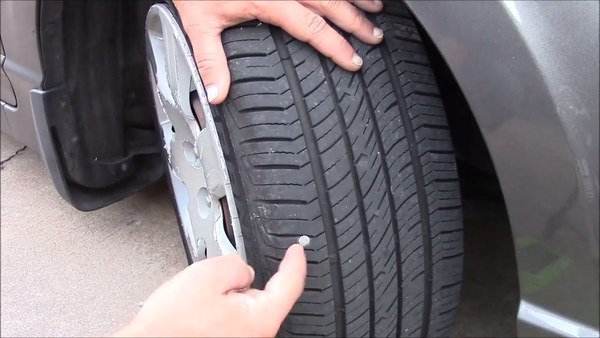 Damage to the bead flanges, especially steel ones, can lead to depressurization of a tubeless tire. If a tire is damaged, it must be repaired by specialists using equipment designed for this purpose.
Damage to the bead flanges, especially steel ones, can lead to depressurization of a tubeless tire. If a tire is damaged, it must be repaired by specialists using equipment designed for this purpose.
In case of loss of pressure, do not drive with a flat tire. this will destroy the hermetic layer.
The tube is not inserted into the tubeless tyre. At first glance, you increase the strength of the tire, in fact, an air cushion is formed between the chamber and the pressure layer, contributing to the destruction of the latter. If the load on the wheel is increased (for example: a sharp turn), the wheel may break.
There are complaints about tubeless tires due to weak sidewalls. I would like to say that this is not so. There are no perfect tires. The manufacturer seeks from the tire not only durability, but also comfort when driving. It is the softness of the sidewall that gives a feeling of smoothness in movement. Having made a rigid sidewall, we will be able to jump on curbs and sewer wells on our car; when driving on a flat and good road, we will feel uncomfortable.
| Tire labels - how to read? From November 1, 2012, tires sold in countries within the European Union must have special stickers. They contain information, in particular, about the fuel.. July 11, 2022, 11:34 | |
| Causes of tire wear Tire wear is often the result of too much speed at which we move. However, there are many more factors influencing this process. Tire condition during .. 04 July 2022, 11:58 | |
| What is the minimum tread depth allowed? The tread of a tire is sometimes analyzed in terms of appearance and shape, modern technologies implemented by the manufacturer, or performance in winter conditions. However, the key parameter of tires in.. June 23, 2022, 10:06 | |
Tire deformation and side ties. What to do with them? What to do with them? One of the remarkable and main features of the structure of the inner part of any tire is the threads that make up the cord. For quite a long time they have a radial location at.. June 08, 2022, 10:21 | |
| Wheel alignment - do I need to change tires? If your vehicle behaves on the road, it may mean that you need to replace suspension components, steering system, wheels or tires. For this may.. 07 April 2022, 15:47 | |
Tubeless tires: device, advantages over tube tires
Today, car manufacturers are equipping their models with tubeless tires. Chamber rubber is a thing of the past, now it can only be found on old foreign cars or domestic cars. If you are the owner of just such a car, then this article will help you make a choice in the direction of tubeless tires.
We will look at how chamber and tubeless tires differ, the device and features of modern tires.
Let's start with tube tires. They consist of two elements: a chamber made of a rubber compound in the shape of a torus, and a tire. The composition of the rubber should provide not only strength, but also the elasticity of the tire. When air is supplied inside the chamber, it should increase slightly in size according to the principle of a balloon. The dimensions of the tube and the tire itself must match perfectly, as the tube must fit inside without creases.
Their appearance will quickly cause the tire to become unusable. Tube tires do not last long, as their main element constantly experiences deformations under the influence of high temperatures. It is unprofitable for manufacturers to spend money on creating a “hardy” camera, so even domestic manufacturers have refused such tires.
Tubeless car tires consist of one tire.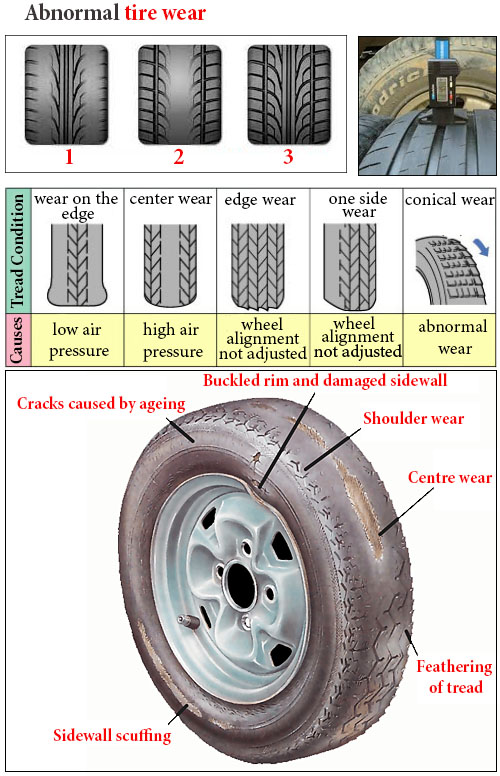 A 2 mm rubber layer is applied to its inside, due to which the tire does not allow air to pass through. Manufacturers also thought about the joint between the rim of the disc and the sides of the tire, where air leakage is also possible. To prevent this, the board is covered with a layer of soft rubber. The principle of operation of a tubeless tire is quite simple.
A 2 mm rubber layer is applied to its inside, due to which the tire does not allow air to pass through. Manufacturers also thought about the joint between the rim of the disc and the sides of the tire, where air leakage is also possible. To prevent this, the board is covered with a layer of soft rubber. The principle of operation of a tubeless tire is quite simple.
The tire bead sits on the rim shelf, in tubeless tires this element has a rounded protrusion, due to which the tire wraps around the bead from two sides. This solution ensures reliable tightness of the connection. Motorists know that a certain amount of air must enter the tire; in a tubeless tire, this issue is resolved with a valve that is installed on the rim of the rim. Now you know how tubeless tires differ from tubeless ones.
To understand why chamber models are a thing of the past, it is worth considering their disadvantages:
 Light weight is the main advantage of tubeless tires, as a large mass increases the inertial movement of the wheel when driving on uneven road surfaces, as a result, the undercarriage wears out much faster.
Light weight is the main advantage of tubeless tires, as a large mass increases the inertial movement of the wheel when driving on uneven road surfaces, as a result, the undercarriage wears out much faster. We already know how a tubeless tire works, so it's easy to see the advantages over tubeless tires. Tubeless tires have improved tightness due to soft rubber at the joints, and malfunctions associated with chafing of elements have been eliminated.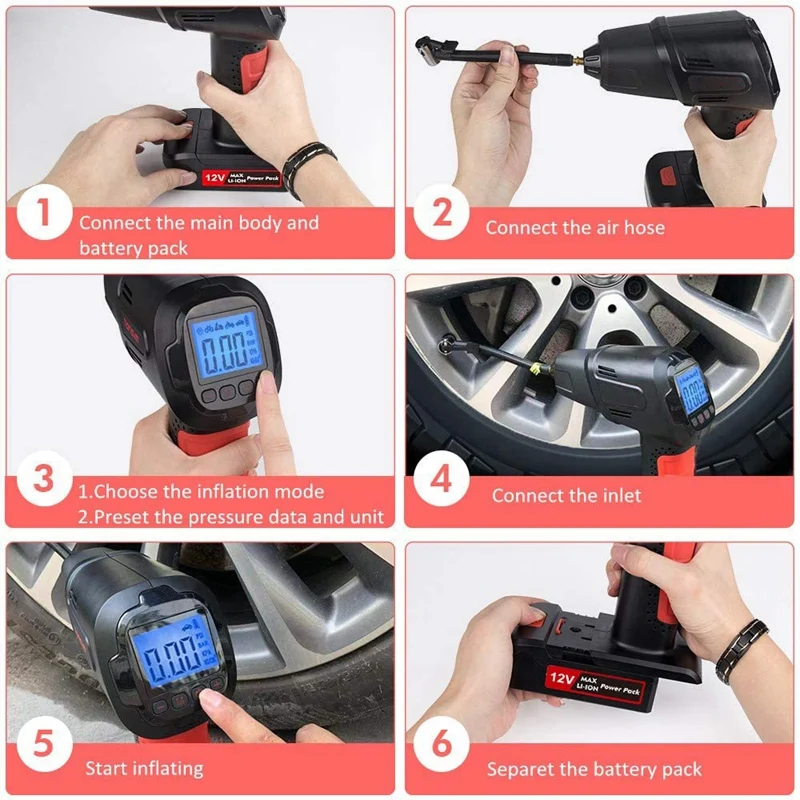 After a puncture, the tire does not fail, and if necessary, you can drive with a damaged tire to the nearest tire changer. The service life of chambered rubber is much longer, since it is not subject to overheating.
After a puncture, the tire does not fail, and if necessary, you can drive with a damaged tire to the nearest tire changer. The service life of chambered rubber is much longer, since it is not subject to overheating.
This is important - the disadvantages of tubeless tires and mounting features
Tubeless and tubeless tires differ not only in design, but also in the method of installation and repair. The main disadvantage of such rubber is installation, which will be problematic to do with your own hands. During mounting and dismantling, it is very easy to damage the bead flanges, which will lead to depressurization of the tire. Repair of a punctured tire should be carried out by professionals using special equipment. That is, on the way you will not be able to “patch up the rubber”.
Answer to the question “Which is better for tube or tubeless tires?” we gave. The main criterion for choosing any component is safety; if a tubeless tire is punctured at high speed, you will not lose control.